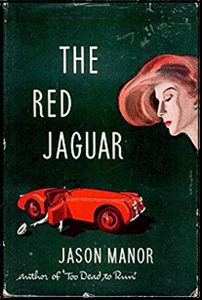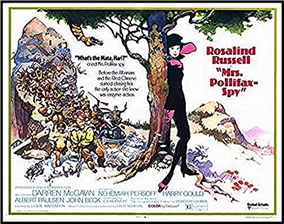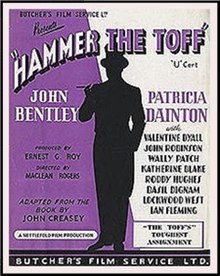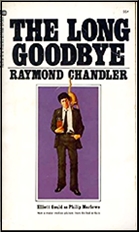March 2020
Monthly Archive
Thu 26 Mar 2020
Posted by Steve under
Reviews1 Comment
IT IS PURELY MY OPINION
Reviews by L. J. Roberts
JACK FREDRICKSON – The Black Cage. Milo Rigg #1. Severn House, hardcover, February 2020. Setting: Contemporary Illinois/Indiana.
First Sentence: The color had been sucked from everything, not just the dead.

Milo Rigg is a reporter who’s lost his byline due to perceived inappropriate behavior while on his last story. Still working in a city where police corruption is the norm, on a paper at the edge of going under, submitting his stories under his boss’s name, and suffering nightmares about his late wife, an old case comes alive when new bodies are discovered. Now, with a new boss, and new clues, Rigg is determined to follow the story to the killer and to regain his reputation.
If one has previously read Fredrickson, this is a book darker in tone and emotion than his previous works, and that’s not a bad thing as it’s always nice to see an author stretch. The introduction to Milo through his interaction with senior sheriff’s deputy Jerome Glet is very effective. As a character, Milo stands out. Fredrickson makes one feel the pain of his loss, both personally and professionally, his frustration with his job, the demise of print newspapers overall, and the corruption and ineptitude of the police. Without words, one feels the turmoil of Milo’s emotions– “There was no ‘before’ to it, no past. It was still all so damned present.”
Fredrickson’s descriptions are evocative. They perfectly reflect the tragedy of the scene– “Snow began to fall in big wet flakes, like tiny shrouds descending to cover the horror of what had been found there.” One is very effectively drawn into the story by hints, traces of things; by intriguing references to people, places, and events.
The inclusion of the news articles, along with Milo having other small stories to write, adds realism to the story and provides details in a concise manner without filling space with exposition. Fredrickson accurately, and sadly, conveys what has happened to print newspapers– “…the third floor, the reporters’ floor, was now a ghost town. Half the cubicles were empty… People no longer read the ink of the news; … they wanted that in tiny bits on screens that they could delete in an instant if it was too upsetting or demanded too much concentration…”
The increase in tension is subtle and very well done. There is one point where one may think they understand what is happening and suspicions arise. It’s best to trust Milo and follow along as he builds scenarios, setting out to prove, or disprove, them.
Milo’s recurring dream of the black cage is a constant theme. However, the reveal of the association is both anti-climactic but strangely satisfying. There are a lot of characters, but Fredrickson is very good at reminding one of who each character is and their role. The plot twists are well-timed and very effective.
The Black Cage has a startling climax, an excellent final twist, a nice tie-up, and a strangely bittersweet ending. It’s important to note that, although dealing with the deaths of children, the story is not gruesome in that the murders happen off-page and are a fait accompli when one learns of them. The beginning of a new series, Milo is a character one looks forward to following into upcoming books.
Rating: Very Good.
Wed 25 Mar 2020
JOHNSTON McCULLEY “The Man Who Changed Rooms.†Novelette. Creighton Marpe #1. First published in Clues, February #2, 1929. Collected in The Johnston McCulley Megapack (Wildside Press, Kindle edition, March 2015).
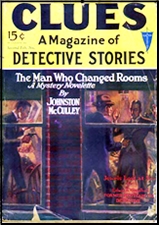
Johnston McCulley is known today, if at all, as the creator of the pulp western hero Zorro, and if it hadn’t been for Walt Disney, even such a dashing character as Zorro may be unknown to readers as some of the other series characters he came up with. Only the most dedicated collectors of old pulp magazines will remember these folks: Black Star, The Spider (the earlier version), The Mongoose, Thubway Tham, Green Ghost, The Thunderbolt, The Avenging Twins, and The Crimson Clown.
He also wrote hundreds of standalone stories for the pulp magazines in all genres but primarily mysteries and westerns, along with several dozen hardcover novels. As for secret agent Creighton Marpe, I’ve listed this as his first story, but in fact, while there are possibilities in the character, it seems as though there never was another one.
His task in “The Man Who Changed Rooms†is outwardly a simple one. He’s to take the train from New York City to Kansas City, pick up a top secret document, and bring it back to Manhattan. A job to be completed with code words and the utmost caution. The reason Creighton Marpe is called “the man who changed rooms†is that when he needs a room in a hotel, he books three, and when he buys tickets for a train, he buys at least two.
Along the way he runs across various operatives for the other side, whom he invariably taunts in jaunty carefree fashion. Also along the way his path crosses that of a fellow agent on his side, Alla Stimney, a young woman he is rather fond of, a fact that causes them problems when both are being held captive by the aforementioned other side.
There is no depth to the story, nor is the prose anything but rudimentary. but it’s told in such breakneck fashion, the non-sophisticated reader may not even notice. Of course you must realize that I’m paid to notice such things, but somehow or another, I enjoyed the story anyway. Stories taking place largely on trains often have that effect on me.
Wed 25 Mar 2020
Posted by Steve under
Reviews[4] Comments
REVIEWED BY DAN STUMPF:
JASON MANOR – The Girl in the Red Jaguar. Steve Summers #1. Popular Library Eagle #EB42, paperback; 1st printing, June 1955. Originally published as The Red Jaguar (Viking, hardcover, 1954.

A gift from a friend who found it in a thrift store somewhere in the Jersey Wildlands, and an excellent all-around hard-boiled mystery.
“Jason Manor†turns out to be a pen name of Oakley Hall, author of Warlock and a literary lion of the 1950s, whose circle included Michael Chabon, Thomas Pynchon, and Amy Tan. With a name like that behind the name on the book, one expects something better than average. And one — this one, anyway — is not disappointed.
The story opens with ex-cop, ex-PI Steve Summers looking for his ex-wife Verna’s ex-husband Ted in Westhaven, a town so crooked the criminals have to catch each other. It seems Ted left Verna without bothering to get a divorce. Verna didn’t let it bother her either, but now Ted’s come into money and she wants her share.
Problem is, Ted’s affluence comes from his new employment as business manager for Westhaven’s local gang boss, and he can make trouble for anyone who tries to shake him down. Serious trouble. The kind where six of your friends carry you out by the handles.
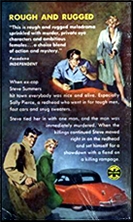
Manor spices the mix with the gang boss’s pretty and restless daughter, a couple of bent cops trying to straighten out, a fainthearted DA and his ambitious underling, a couple of mob-style enforcers….
In lesser typing fingers these would all have been stock characters, but Manor/Hall breathes life into the smallest of them. Even the local gang boss becomes a figure of sympathy, and Steve Summers (remember him?) the hero of the piece, has a self-destructive relationship with his ex-wife that rings true and adds a few wrinkles to a plot that constantly surprises.
For all that Jaguar is still a thing of par-boiled pulp, it’s far enough above the average Red Harvest rip-off to merit seeking out.
Editorial Note: A second and final adventure of Steve Summers was recorded in The Pawns of Fear (Viking, 1955; no paperback edition).
Tue 24 Mar 2020
MRS POLLIFAX – SPY. United Artists, 1971. Rosalind Russell (Mrs. Pollifax), Darren McGavin, Nehemiah Persoff, Harold Gould, Albert Paulsen, John Beck, Dana Elcar, James Wellman. Screenplay by Rosalind Russell (as C.A. McKnight), based on the novel The Unexpected Mrs. Pollifax by Dorothy Gilman. Director: Leslie Martinson.
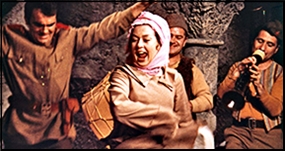
I have a small confession to make. I’ve never read any of Dorothy Gilman’s books about the genteel elderly lady spy, Mrs Emily Pollifax, of which there are 14 of them, The Unexpected Mrs. Pollifax being the first. The combination of a cozy mystery with a serious spy story was just never anything I wanted to follow up on, even though I’ve had many an opportunity to do so.
The good news is that in spite of some television-level production values early on, Mrs. Pollifax – Spy turned out to be an enjoyably amusing way to spend two hours. To back up some, though, Emily Pollifax is a widow living in Montclair, New Jersey, who has always wanted to be a spy, and now that her children are grown and living far across the country, she decides to offer her services to, where else, the CIA.
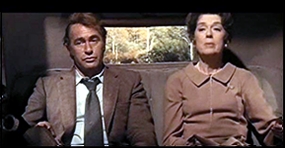
And believe it or not, they have just the right assignment for her. She’s to go to Mexico as an ordinary tourist – no great difficulty there! – and bring back a book in which vital information is concealed. There’s a rough patch in the story line right along here, as it was hard to follow exactly what goes wrong,, but of course in a movie or book such as this, something indeed is guaranteed to go wrong.
So wrong indeed that Mrs Pollifax ends up in a ancient citadel of a prison in Albania, handcuffed to a fellow spy, but a real one, named Farrell (a delightfully exasperated Darren McGavin). Well, pluck being Mrs. Pollifax’s middle name, the first thing she decides to do is to work out a plan to escape.
I am not telling you anything you will not be surprised to know, but the ever resourceful lady does just that. At two hours in length, the movie is longer than it really should have been, but watching the fantastically talented Rosalind Russell in action will get you through the parts that sag just fine. (And as a closing note in that regard, this was evidently a pet project of hers, and at the age of 64, she carries on in her inimitable and consistently irrepressible fashion, in this her final theatrical film.)
Tue 24 Mar 2020
CATHERINE DAIN “Too Many Cooks.†Short story. PI Freddie O’Neal. First published in Murder Most Delicious, edited by Martin H. Greenberg (Signet , paperback original; 1st printing, March 1995). Collected in Dreams of Jeannie and Other Stories (Five Star, hardcover, 2003).
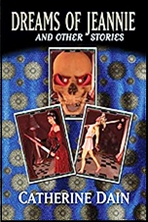
Although she may not be actively writing, Catherine Dain is the pen name of Judith Garwood, (1941- ), who among other works has written seven novels chronicling the adventures of Reno-based PI Freddie O’Neal, along with two or three stories she was in.
From this story we learn that she is unconventional in nature, lives alone, but while she is in close contact with her mother, who lives in town, she does not get along particularly well with her stepfather. You might say that Sue Grafton and Kinsey Milhone were responsible for quite a few other PI’s who followed along in the latter’s wake, and you would be correct.
In “Too Many Cooks,†she is hired to find out who has been playing nasty tricks on a local live action TV show. It is suggested that she pose as the lady chef’s assistant, but since the best she can do is left the corner of cellophane cover before putting a frozen meal into the microwave, it is decided that it would work better if she pretended to be the author of the lady chef’s would-be memoirs instead.
The story is too short to go anywhere, and since her job is really that of prevention instead of actually solving a case, it really has only a very little way to go. A brief but enjoyable glimpse into Freddie’s life is all we get here.
Note: I reviewed Sing a Song of Death, number two in the series here:
The Freddie O’Neal novels —
1. Lay It on the Line (1992)
2. Sing a Song of Death (1993)
3. Walk a Crooked Mile (1994)
4. Lament For a Dead Cowboy (1994)
5. Bet Against the House (1995)
6. The Luck of the Draw (1996)
7. Dead Man’s Hand (1997)
Mon 23 Mar 2020
REVIEWED BY DAVID VINEYARD:
HAMMER THE TOFF. Butcher’s Film Service, UK, 1952. John Bentley, Patricia Dainton, Valentine Dyall, John Robinson, Roddy Hughes, Wally Patch. Screenplay John Creasey, based on his novel. Directed by Maclean Rogers.
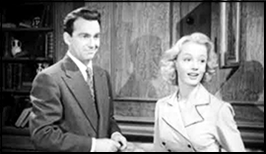
An elegant top-hatted figure in white tie and tails, sporting a long cigarette holder, walks out of a West End club and is silhouetted against a wall, introducing us to the titles, and to the Honorable Richard Rollinson, aka the Toff.
This once “lost†film is currently available on Amazon Prime.
In this case the Toff is played by popular British leading man John Bentley (Calling Paul Temple) whose career in the late forties, fifties, and sixties spanned British film and television, often as not in crime films.
It’s just about perfect casting too, with Bentley managing to be suave, tough, smart, romantic, and all with an appropriately light touch in this extremely faithful adaptation of the John Creasey novel that manages to pack just about everything and everyone in from the popular book series (alas, no Aunt Gloria).

For anyone who came in late, the Toff, Richard Rollinson, is a well-born amateur crime fighter well connected at Scotland Yard with his friend Inspector Grice (Valentine Dyall) and in London’s criminal East End with pub owner and ex-prize fighter Bill (here Bert) Ebbuts (Wally Patch). Aided by his valet and invaluable man Jolly (Roddy Hughes) Rollinson, known as Rolly to his friends, cruises on the sunny side of the law but only just, leaving behind his calling card, a caricature of a man in top hat, monocle, and smoking a cigarette in a long holder.
Hammer the Toff was Bentley’s second outing as the Toff, Salute the Toff coming earlier (1951), and turns out to be a fast-paced and well done B level thriller from the reliable Maclean Rogers.
As in the Creasey novel, we are plunged right in when Rolly, on holiday, enters a compartment on a speeding train occupied by beautiful Susan Lancaster (Patricia Dainton) just moments before two men on a waiting hill side fire into the compartment as the train passes.
Without much ado we discover Susan Lancaster’s uncle (Ian Fleming, who was the intended victim on the train) has a formula wanted by a criminal who calls himself the Hammer. In typical style the Toff foils two Spaniards who try to rifle Susan’s hotel room, and throws himself full into the investigation, but the next day when her uncle is murdered in front of him and Susan in a crowd all seems lost.
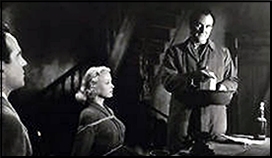
From his friend Grice, Rolly learns that the Hammer was a Robin Hood type well loved in the East End who suddenly a few months earlier committed a murder and has since turned deadly. He wants the formula, which Susan has no idea where it may be, and will stop at nothing to get it.
Rolly, being Rolly, takes Susan into his and Jolly’s protection after thwarting an attempt to kill Susan with a poisoned syringe in a brief case, and at Grice’s request heads for the East End to try and use his connections there to get a hand on the Hammer.
What he finds surprises him, because the East Enders insist the Hammer is innocent, a Robin Hood above suspicion (a nod surely to fellow Thriller alumni Leslie Charteris and the Saint in his early outlaw days), and when Rolly arranges to meet with him he is impressed with the man named Linnett (John Robinson) who swears he is being impersonated, but determined to uncover the fake Hammer and mete out his own justice.
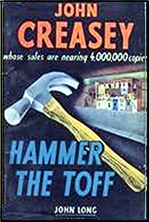
Unfortunately before Rolly can finish feeling Linnett out the police arrive and Rolly finds himself unjustly hated by his East End friends for having betrayed the Hammer.
From then on the film races to the finish, with mysterious messages hidden in plain sight, evil minions, angry former allies in the East End, the fake (or is he?) Hammer, and an uncomfortable truce between the Toff and the (real?) Hammer.
Hammer the Toff is a fast moving B, well written (credit to Creasey for getting so much of the book into a 71 minute format without being crowded), attractively played, well directed by an old pro, and obviously with some expense in terms of sets and location photography. Among other small favors they get the Toff’s flat almost exactly as I imagined it in the books, right down to the entrance and his collection of trophies, a nice touch for any film based on a popular series of books.
If you like the Toff, Creasey, and British B thrillers in general, this is an attractive and well done entry in a series that sadly didn’t go anywhere.
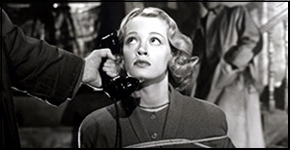
Truth is, the Toff just didn’t fare very well outside of The Thriller and books. In addition to the two films the Toff appeared in several black and white comic digests in the Super Detective Library, and two BBC radio serials (“The Toff and the Runaway Bride” and “The Toff on the Farm”). It wasn’t until the mid-1960s and the Pyramid paperback reprints here that he even had an American imprint, though the Baron had appeared early on.
The television version of this book was just an episode of Patricia Dainton Presents from 1958 edited from this film.
But for long time fans like me, this is a delightful chance to see Creasey’s creation in action, with John Bentley just about perfect as the Toff we know and love. He’s the face I will associate with the character from now on, and that is a compliment.
Sun 22 Mar 2020
LAWRENCE G. BLOCHMAN “Dr. Coffee and the Pardell Case.†First published in Ellery Queen’s Mystery Magazine, June 1972. Probably never collected or reprinted.
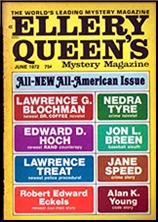
Lawrence Blochman had a long illustrious career as a mystery writer, starting as an author of thrillers in the 1930s and 40s before converting to more traditional detective fiction after the war. His best known series character in the latter end of his career was Dr. Webster Coffee, chief pathologist at Pasteur Hospital in Northbank, Ohio. He was also the personal medical examiner for Lt. Max Ritter, of the local police department. They appeared together in one novel and two hardcover story collections, plus a few later stories such as this one that have never appeared in book form.
I called this a locked room story, for indeed it is, for about a day in the story or less. When the victim calls Ritter in a panic, the latter rushes to the scene and finds the dead man shot to death in a locked room with no possible access to it. This particular aspect of the mystery is soon cleared up by Coffee’s colleague Dr. Mookerji, who determines that the dead man could have survived the shot long enough for him to enter the room and lock the door behind him before dying. Not a lot of mystery there!
Neither Ritter nor Coffee are given much personality in this one. Two full pages are spent on showing what a miserable person the victim was, however, a man who pulled himself up from his bootstraps as a child to become a rich and powerful man – whom everyone hated. From a mystery reader’s point of view, this provides for a whole list of suspects, each one with a motive. It is the opportunity that each of them may have had that Ritter has to look into. Dr. Coffee, when it comes down to it, does not have a whole lot to do in this one.
Good old-fashioned police work, that’s all that’s needed in this one.
Sun 22 Mar 2020
JON L. BREEN “The Babe Ruth Murder Case.†Ed Gorgon #4. First published in Ellery Queen’s Mystery Magazine, June 1972. Collected in Kill the Umpire: The Calls of Ed Gorgon (Crippen & Landru, hardcover/paperback, 2003).
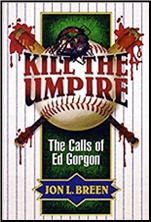
Ed Gorgan is a baseball umpire who somehow seems to keep stumbling across unusual cases of murders. My my count there have been fourteen of such instances (see below), but there may have one or two that I’ve missed, hopefully not more. In “The Babe Ruth Murder Case,†what requires his attention is the shooting of the owner of a sports bar where he and police lieutenant Steve Appleman just happen to be hanging out.
The fact the victim was well known for his criminal activity, including blackmail, means that there any number of suspects, and many of them who had the opportunity are strong possibilities are connected to his death by the clue on the dead man’s desk: the name “Babe Ruth†in his appointment book for that evening.
This case is a textbook example, only six pages long, of taking each of the suspects in turn and eliminating them one by one by the application of sheer reason, reminiscent in many ways of many an Ellery Queen story, both long and short. More praise than that I cannot give.
The Ed Gorgon series —
Diamond Dick (ss) Ellery Queen’s Mystery Magazine Oct 1971
Horsehide Sleuth (ss) Ellery Queen’s Mystery Magazine Nov 1971
The Body in the Bullpen (ss) Ellery Queen’s Mystery Magazine May 1972 *
The Babe Ruth Murder Case (ss) Ellery Queen’s Mystery Magazine Jun 1972 *
Fall of a Hero (ss) Ellery Queen’s Mystery Magazine Nov 1972 *
Old-Timers’ Game (ss) Ellery Queen’s Mystery Magazine Apr 1973
Malice at the Mike (ss) Ellery Queen’s Mystery Magazine Oct 1973
Designated Murderer (ss) Ellery Queen’s Mystery Magazine Jul 1974 *
The Number 12 Jinx (ss) Ellery Queen’s Mystery Magazine May 1978 *
Instant Replay (ss) Ellery Queen’s Mystery Magazine May 1984
Streak to Death (ss) The Second Black Lizard Anthology of Crime Fiction, 1987 *
Throw Out the First Ax (ss) Ellery Queen’s Mystery Magazine Apr 1992 *
Kill the Umpire (ss) Ellery Queen’s Mystery Magazine Nov 2002
Insider Trading (ss) ??, 2003 *
* = Included in the Crippen & Landru collection.
Sat 21 Mar 2020
A 1001 MIDNIGHTS Review
by Marcia Muller
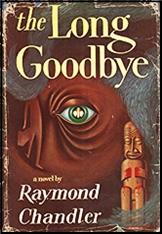
RAYMOND CHANDLER – The Long Goodbye. Philip Marlowe #6. Houghton Mifflin, hardcover, 1954. Pocket #1044, paperback, 1955. Reprinted many time, both in paperback and hardcover. TV adaptation: “The Long Goodbye” on Climax, 07 Oct 1954. with Dick Powell as Philip Marlowe. Film: United Artists, 1973, with Elliott Gould as Philip Marlowe.
The title of this novel is apt. It is a long book and a complex one, and its detractors say they wish Chandler had said goodbye two-thirds of the way through. What these critics fail to understand is that the novel is one of the most realistic looks into the day-to-day life of a private investigator, and the central plot element, that of Philip Marlowe’s friendship for the mostly undeserving Terry Lennox, is a compelling unifying element. In it we also see a different side of Marlowe than in Chandler’s other novels: the man who is as honorable in his personal relationships as he is in his professional ones.
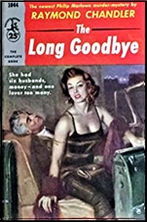
The story begins when Marlowe first sees Terry Lennox, dissolute man-about-town: he is “drunk in a Rolls-Royce Silver Wraith outside the terrace of the Dancers,†a ritzy L.A. nightspot, with a redheaded girl beside him whose blue mink “almost made the Rolls Royce look like just another automobile.” The girl leaves Terry, Good Samaritan Marlowe takes over, and a friendship begins.
It is a friendship that Marlowe himself questions, but it persists nonetheless. Marlowe tells Lennox he has a feeling Terry will end up in worse trouble than Marlowe will be able to extricate him from. and in due course this proves true. The redhead, Terry’s ex-wife, whom he admittedly married for her money, is murdered in the guesthouse at their Encino spread and the trouble that Marlowe sensed begins.
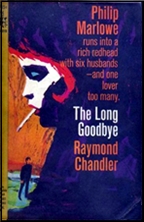
Lennox runs to Mexico, and it is reported that he made a written confession and shot himself in his hotel room. But something feels wrong: The Lennox case is being hushed up, and Marlowe begins to wonder if his friend really did kill his ex-wife. A letter that arrives with a “portrait of Madison” – a $5000 bill that Terry had once promised Marlowe – convinces him his suspicions are justified.
He tells himself it is over and done with, but he isn’t able to forget. The matter plagues him while he is working a case involving an alcoholic writer of best sellers in wealthy Idle Valley (where, he says, “I belonged … like a pearl onion on a banana split”). It begins to plague him even more when Sylvia Lennox’s sister, Linda Loring, appears and plants additional suspicions in his mind. The suspicions spur him onward, and finally his current case and the Lennox case come together in a shattering climax.
At the end Chandler neatly ties off all the strands of this complicated story, and provides more than a few surprises. An excellent novel with a moving ending.
———
Reprinted with permission from 1001 Midnights, edited by Bill Pronzini & Marcia Muller and published by The Battered Silicon Dispatch Box, 2007. Copyright © 1986, 2007 by the Pronzini-Muller Family Trust.
Sat 21 Mar 2020
Posted by Steve under
Reviews[4] Comments
REVIEWED BY BARRY GARDNER:
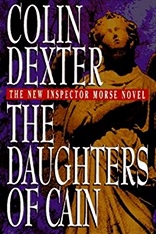
COLIN DEXTER – The Daughters of Cain. Inspector Morse #11. Crown, US, hardcover, 1995. Ivy, US, paperback, 1996. Published earlier in the UK by Macmillan, hardcover, 1994. TV movie: ITV, UK, 27 Nov 1996 (Season 9, Episode 1) with John Thaw as Chief Inspector Morse and Kevin Whately as Detective Sergeant Lewis.
I have not heretofore been a Morse fan. There, I’ve said it. Everyone else seems to be, though, so I thought I’d try another one, as I haven’t read that many.
Dr. Felix McClure, late of Woolsy College, Oxford, is dead. Butchered. Morse and Sergeant Lewis think they know who did it, but they can’t find the weapon, and the man’s wife alibis him. And then there’s the couple’s daughter, a runaway and prostitute strangely attractive to both McClure and Morse.
While the case meanders on, Morse must deal with both his deteriorating health and a potential reduction in rank due to an efficiency study. The former, it seems, is demanding payment for all the years of Scotch, cigarettes, and general neglect.
There’s no question but that Morse is one of the major figures in modern crime fiction, my own lukewarm attitude notwithstanding. Though the amount contributed to this popularity by television is an open question. In fairness, not only did I like this book better than any others I’ve read if his, but there’s no doubt that his characterization is superb.
Dexter writes a particular kind of story: leisurely, convoluted, and told much in the way Morse’s mind works – in fits and starts, and darting this way and that. The prose is excellent, and none of the characterizations are less than very, very good. This seemed to me a bit different in tone than the previous ones I’d read, a bit mellower, even more sentimental.
Bur perhaps I was just in a mood more conducive to enjoyment of it. Whatever. I did enjoy it considerably, and am even tempted to go back and try some of the earlier ones.
— Reprinted from Ah Sweet Mysteries #19, May 1995.
« Previous Page — Next Page »




